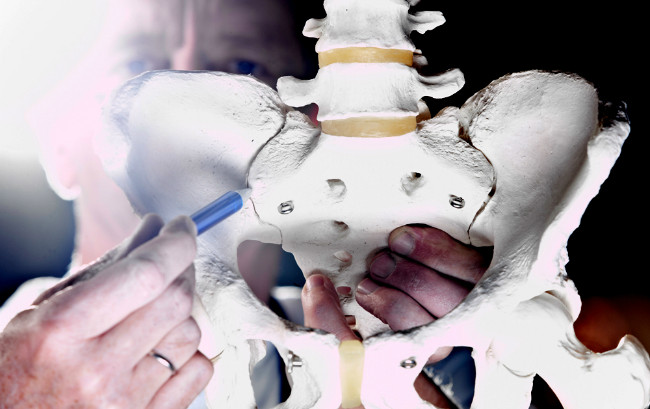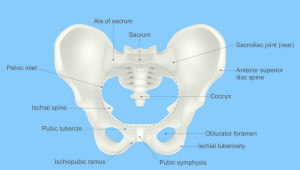SI Joint – Why Do I Feel Pain?
Let’s Get Familiar with the Sacroiliac Joint
The sacroiliac joint (SI Joint) is the joint that connects the sacrum of the spine to the right and left side of the iliac bones (hip bones). The iliac bones are the large bones that form the pelvis, and the sacrum is the triangular structured bone located at the lower part of the spine, just above the tailbone. The sacroiliac joint is a very important joint as it supports the weight of the entire upper body; when upright, it helps with balance while walking, and helps absorbs any shock to the spine.
However, there are certain activities that can irritate the sacroiliac (SI) joint, which can lead to back pain. The most common reasons for the discomfort include the natural wear and tear due to aging, any injuries of the joint (like a severe fall), abnormal gait (the way a person performs activities involving constant pounding like walking, jogging), medical conditions, loosening of the ligament, pregnancy, and too much or too little movement.
What does SI joint pain feel like?
SI joint pain can be felt in different areas and can range from dull to sharp. SI joint pain can be felt on the lower back and/or hip and can radiate into the groin or upper thigh area. The pain is usually one-sided, but can occur on both the right and left side. Additionally, pain can be felt in the lower back or buttocks, which can radiate to the legs. The pain usually stays above the knee, but can extend to both the ankle and foot. SI joint pain can feel more painful by sitting, standing, walking, laying down, or climbing stairs. Also, SI joint pain can mimic sciatic nerve pain and can cause numbness or tingling and weakness in the legs.
How is SI joint pain diagnosed?
First, a medical assessment of all symptoms and medical history will be made. Then a physical examination will be completed to help determine the source of pain and to examine for tenderness over the SI joint(s). Diagnostic studies, such as x-rays, MRIs, or CT scans, may be ordered to further examine the area of pain.
Additionally, the physician may perform a diagnostic SI joint injection to confirm the cause of pain. This is the procedure in which the physician injects a local anesthetic and, possibly, a corticosteroid medication. The injection is usually given using x-ray fluoroscopy (if a regular x-ray is a picture, then fluoroscopy is a movie) to ensure accurate needle placement in the SI joint. The pain will be evaluated before and 20-30 minutes after the injection; monitoring of the pain is recommended for the next week. The suspicion that the SI joint is causing the pain will be confirmed if the pain decreases by more than 75%.
What are the SI joint treatments?
When treating SI joint pain you need to start by stopping any activities that cause pain. If you are experiencing pain from an exercise and/or sport, seek medical help from a sports medicine doctor or an orthopedist. However, there are many other treatment options, including nonsurgical treatments, injections, nerve ablations, and surgery.
Nonsurgical Treatment: Physical therapy, chiropractic manipulation, and stretching exercises can be some of the treatments used to help relieve SI pain. Additional treatment can include oral anti-inflammatory medication, topical ointment, topical patches, and mechanical bracing.
Joint Injections: Steroids can reduce the swelling and inflammation of the joint and nerves. Additionally, injections are a minimally invasive procedure in which a corticosteroid and an analgesic numbing agent are injected in to the SI joint. Generally, if the injections are helpful, they can be repeated up to three times a year. However, injections tend to be a temporary relief.
Nerve Ablations: Also referred to as Radiofrequency Ablation, this method prevents the transmission of pain signals. The procedure produces thermal energy that destroys the nerve fibers which carry pain signals from the joint.
Surgery: The surgical treatment is used once all other treatments have been exhausted. Your physician may recommend minimally invasive SI joint fusion surgery. A small incision is made and the surgeon will place titanium implants and bone graft material to stabilize the joint and promote bony fusion of the joint.
The road to recovery is waiting! Don’t delay – come seek medical treatment for you SI joint or any joint pain soon. Remember, joints are extremely important and the SI joint supports the upper body. Don’t exacerbate your pain by waiting.
For more information, or if you wish to schedule an examination, request an appointment today!
Medically Reviewed by Dr. Roman Shulze
If you have questions about constant lower leg pain or believe you might have SI joint pain, visit Healthpointe, we can help! If you have questions, give us a call at 888-719-8448. At Healthpointe, we are passionate about health, mindfulness, prevention, and helping you live your healthiest life. Walk in to any of the Healthpointe medical offices, such as the Perris Office near Nuevo, Sun City, Canyon Lake, Homeland, and Lakeview.


